Toilets
How To Fix a Leaking Toilet
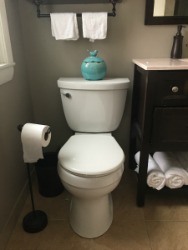 Do you know how to fix a leaking toilet? Leaks can be a little deceptive and it is not always easy to tell where they are coming from.
Do you know how to fix a leaking toilet? Leaks can be a little deceptive and it is not always easy to tell where they are coming from.
The first step is troubleshooting your problem. The 'Toilet Leak Troubleshooting' section below, will help you to do that. After that, you want to get the needed parts and tools. With everything thing you need, just follow the instructions provided to repair your leaky toilet.
Not sure if your toilet is actually leaking? See the article on 'Fixing Toilet Problems' for a complete listing of potential problems and solutions.
The four possible locations are: (1) The Fill Valve inlet. Usually just requires that you tighten the tank seal nut. (2) The Flush Valve seal. Many times , tightening the bolts will solve this problem. (3) The Toilet Flange seal can leak at the floor. This requires pulling up the toilet and replacing the wax ring. (4) The water valve or supply tube can also leak. Tightening may fix it, replacing washers or replacing tubes and valves may be required.
Toilet Leak Repair - Issues Involved
What Can You Save? - Leaks can be a little more challenging, even for a repairman. Initially it will cost you $50 to $100 for a service call, plus parts. If it takes longer than the initial time period (this varies), they generally charge you in fifteen minute increments. $15 to $35 per fifteen minute period. It is unlikely that you need a new toilet if it is just leaking. Assuming a repair period of one service call plus one half hour the Savings would be $80 to $170. Parts would be extra of course, and marked up at a repair shop's pricing.
How Hard Could It Be? - Depending on where the leak occurs the difficulty level can vary. These repairs will have a Difficulty Level of: A Bit of Work. These repairs require a Skill Level of: Handyman. For and explanation of the terms in this section, see 'How to Use This Site'.
Check the Simple Things! - We will cover it in the steps below, but tightening things up is usually pretty simple. If something is obviously loose, get a wrench and tighten it. It may be as simple as that.
What Can Go Wrong? - Leaks mean water, water can be a problem. Left unattended, leaks can damage finishes and structural elements. Letting a leak go for a long time can do thousands of dollars of damage. Fixing it quickly will always be the best course of action. Anything that can be damaged by water should be removed from the area before the repair is attempted. Getting the toilet partially repaired before it gets too late or the parts store closes can leave the toilet not operating. One trick is that a toilet can be flushed by dumping a couple of gallons of water quickly into it from a pail. This mimics the normal function of the toilet tank.
Troubleshooting Toilet Leaks
The descriptions below help you to locate the leak and act accordingly. Try to locate the leak before you take action. A leak at the toilet flange may only leak when the toilet is flushed. Use a dry cloth to soak up the water and then use your finger to determine where the leak is coming from.
Water Trickles Into the Bowl and the Tank Refills Periodically
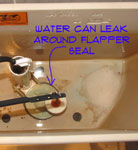 You hear a trickling sound inside of the tank. This is especially noticeable when it is quiet. This is usually accompanied by the toilet tank refilling periodically.
You hear a trickling sound inside of the tank. This is especially noticeable when it is quiet. This is usually accompanied by the toilet tank refilling periodically.
This problem is related to the toilet flapper and the toilet flush valve. The toilet flapper raises when the toilet is flushed. After the water has drained into the bowl, the flapper closes. It seals against the rim of the flush valve. The seal between the flush valve and the flapper is the only thing keeping the water inside of the tank. When this seal fails, you have a leak.
The articles 'Toilet Flapper Leaking' and 'Toilet Flapper Repair' provide information on all of the issues associated with your toilet flapper. This includes instructions on how to fix it.
I have a leak at the base of my tank, where it connects to the toilet bowl.
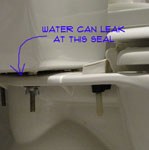 This problem only applies to two piece toilets. However, most toilets are the two piece design. The two pieces consist of a toilet bowl, which is the base unit that sits on the floor and a toilet tank.
This problem only applies to two piece toilets. However, most toilets are the two piece design. The two pieces consist of a toilet bowl, which is the base unit that sits on the floor and a toilet tank.
The toilet tank is mounted to the base unit with bolts. There is a large seal between the tank and the bowl. This seal is compressed by tightening the bolts that hold the two porcelain pieces together. Loose tank bolts can cause the seal to leak. Since the seal is made out of rubber it can also dry out and crack over time. A cracked or worn seal can also leak.
Another potential problem is the bolts. Some toilets use bolts that have a rubber seal around them. There are individual holes in the bottom of the tank for each bolt. You can have the same problem here, a loose bolt or bad seal at the bolt can cause a leak.
The article 'Fixing a Leaking Toilet Tank' has complete instructions for tightening the toilet tank bolts and replacing the seals if needed.
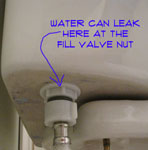 I have a leak where the water supply connects to the tank.
I have a leak where the water supply connects to the tank.
There is another hole in the bottom of the toilet tank for the toilet fill valve. The toilet fill valve regulates the amount of water that is stored inside of the toilet tank. It needs to be connected to the homes water supply.
The toilet fill valve is held in place by a large nut and it has a rubber seal to stop the water from leaking out of the toilet tank. When the nut is loose or the seal is bad, there can be a leak at this location.
For instructions on how to tighten or replace the toilet fill valve, see the article 'Toilet Fill Valve Leaking'.
The water supply line for the toilet is leaking.
Your toilet needs water to operate. The water is provided by a supply line that runs between the shut off valve and the toilet.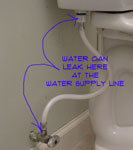 There are actually four different spots that could be leaking on the supply line.
There are actually four different spots that could be leaking on the supply line.
(1) The connection where the valve is attached to the water supply. (2) The connection where the supply line is connected to the water shut off valve. (3) The valve stem seal on the water shut off valve. (3) The connection where the supply line connects to the toilet fill valve.
See the article 'Toilet Supply Line Leaking' for information on how to locate these leaks (pictures included). There are also instructions on how to tighten or repair the problem.
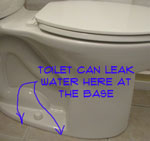 There is water on the floor around the base of the toilet.
There is water on the floor around the base of the toilet.
Just because you have water on the floor, does not mean that the toilet is leaking at the base. Make sure that you do not have another type of leak before you pursue this problem.
A toilet leaking at the base will only occur when the toilet is flushed. That means, well, that the toilet is leaking dirty water from when the toilet is used.
The toilet is connected to the floor with bolts that hold it in place. There is a wax seal between the bottom of the toilet and the toilet flange. When the toilet loosens over time the seal can be broken, causing the toilet to leak.
There are two possible fixes. One is tightening the tee bolts that hold the toilet to the floor. The second is replacing the wax ring. The article 'Toilet Leaking at the Base' has more information and instructions on how to fix this problem.
This is not really a leak at all. This problem comes from condensation on the toilet tank. There are some things that can help. See the article 'Fixing a Leaking Toilet Tank' for some suggestions.
Fixing a Leaking Toilet Tank – Summary
Toilets use a lot of water to operate and water needs to be stored. It is not suprising that they have lots of spots that can leak. Hopefully, you were able to identify your problem and get it fixed.
Did not find an answer to your problem? See the article 'Troubleshooting Toilet Problems' for a listing of all if the toilet issues you might encounter.
How To Unclog a Toilet Without a Plunger or a Snake
Do you know how to unclog a toilet without a plunger or a snake. Essentially, your in a bind without any tools. There are methods that can be tried, but they are not as effective as a good old fashioned plunger.
Time
Waiting for a clog to dissolve can sometimes work.
Water Pressure
You need to be careful with this one. Most toilet bowls will handle two flushes and that's about it if the water is not draining out. A second flush will sometimes build up enough water pressure to push the clog on through.
Chemicals
Chemicals that are strong enough to dissolve clogs are dangerous and should be used with great care.
Zip It
A zip it snake may be long enough to break up a clog in a trap.
Coat Hanger
Yes this can work. A wire coat hanger that has been straightened out can get to a clog and get it loosened up. You may have to play with the shape a bit and work it to get it past the trap.
Remove Toilet to Unclog
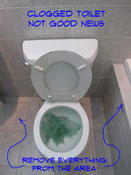 I have unclogged a lot of toilets and I only remember one time that I had to pull the toilet up to dislodge a uniquely shaped toy that was caught solidly on the back side of the trap. You can use a small piece of mirror to look up into the trap if you suspect something is caught. Sometimes the toilet will drain only to clog again if something is caught in it.
I have unclogged a lot of toilets and I only remember one time that I had to pull the toilet up to dislodge a uniquely shaped toy that was caught solidly on the back side of the trap. You can use a small piece of mirror to look up into the trap if you suspect something is caught. Sometimes the toilet will drain only to clog again if something is caught in it.
Removing a toilet to solve a toilet clog problem is a last resort. First try 'Plunging a Toilet', then try 'Using a Toilet Auger' before you consider removing the toilet. One other consideration is your main sewer line. At toilet that won't unclog may be blocked in the sewer line. See the article 'Troubleshooting Drain and Sewer Line Problems' to make sure that your problem is not more serious.
Removing a toilet will involve several steps and is not considered to be an easy job. You are also going to need to replace a some parts when you have the toilet removed. For instructions on removing a toilet, see the article 'How To Remove a Toilet'.
If for you see water in the pipe that is in the floor, it is not your toilet at all. Your sewer line is clogged and will need to be snaked out.
Removing Obstructions From a Toilet
 The last and less desirable reason for a slow flushing toilet is an obstruction. Most of the time when a toilet clogs it is due to the volume that is going through the trap. Other times, something may get dropped in the toilet that won't go through the trap, this will cause the toilet to clog.
The last and less desirable reason for a slow flushing toilet is an obstruction. Most of the time when a toilet clogs it is due to the volume that is going through the trap. Other times, something may get dropped in the toilet that won't go through the trap, this will cause the toilet to clog.
There are three articles that discuss 'Toilet Clogs'. See 'How To Unclog a Toilet', 'Plunging a Toilet' and 'Using a Toilet Auger'. Just about any type of obstruction can be dealt with using the information in these articles.
Children are great and well worth the few problems that they create. Sometimes, not likely the fault of the children, things get thrown in the toilet that shouldn't be there. Toothbrushes, small toys and other objects can get caught in the trap.
How To Remove Objects
When objects get caught in the trap, the toilet still works, but poorly. The obstruction will catch things that go by, slowing down the operation of the toilet. The solution is to get rid of the obstruction.
A toilet auger is the best tool to use when you have this problem. The problem will likely get worse and the clogs will become more frequent. In time the plunger will no longer work and something will have to be done. A slow flushing toilet has now become a clogged toilet.
Using a Toilet Auger or Snake on a Toilet
A toilet snake is an oddly shaped device that has a short section of metal snake that goes through it. It has a hand crank and the snake portion is just long enough to get through the trap on the toilet. Since most objects get caught in the trap, the auger works very well.
See the article, 'Unclogging a Toilet With a Snake' for instructions on how to do it and where to obtain an auger.
Removing Toilet Inlet Sediment
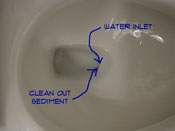 Another reason for a slow flushing toilet is a clogged inlet valve. The water from the tank is fed into the bowl via an inlet that is built into the porcelain bowl.
Another reason for a slow flushing toilet is a clogged inlet valve. The water from the tank is fed into the bowl via an inlet that is built into the porcelain bowl.
This might not be your problem, see 'How To Fix a Toilet' or 'Plumbing Repair' for all of the plumbing related articles.
Sediment can build up in this inlet. This will cause the water coming into the bowl to slow down. As a result the toilet will not flush correctly.
How a Toilet Works
Toilets are designed to create a siphonic action in the bottom of the bowl. A siphonic toilet uses a combination of water pressure and gravity to accmplish this. Since 1994, toilets in the United States can only use 1.6 gallons per flush. Not really a lot of water when you consider that some of the water gets used to clean the bowl and the balance is used to create the siphon, a water cyclone, to use an analogy.
There is an inlet at the very bottom of the bowl, that jets the water in to the outlet pipe to create the siphon. Over time, this inlet can build up with sediment. When this happens, the sediment needs to be cleaned out, or the toilet won't flush properly.
Even when the entire 1.6 gallons is used, if it does not get into the drain fast enough, you won't create a siphon. When this happens, you have what is commonly refered to as a 'Slow Flushing Toilet'.
Older toilets, with older toilets, the problem can be more pronounced. It may seem that with the extra water that an older toilet uses, that there is plenty to go around. However, this is not true.
For one thing, older toilets are, well, 'older' so the sediment has had a lot more time to build up, probably in locations you cannot readily see. The second thing is that older toilets were designed to use a certain amount of water, could be as much as 7 gallons per flush. If all of that water is not used in the proper amount of time, the toilet will flush poorly.
Safety Concerns
Toilets are somewhat dirty by nature. Even in the cleanest house, the dirtiest place is likely to be the toilet. Use gloves when working on or inspecting a toilet.
Disinfecting the toilet prior to any repairs or inspection is also a great idea. Dangerous bacteria can live in, even a seemingly clean toilts.
Where To Look for Sediment
There are several inlets for water in your toilet. Some of them are to rinse the bowl, but the biggest on is at the bottom and it is needed to create the siphon.
There are a series of small water inlets under the rim of the toilet bowl. You will need a mirror to be able to inspect them. They are small, but neccessary. The rinsing water also contributes to the siphonic action. If you see any discoloration or build up, this will need to be cleaned up.
As mentioned above, there is a larger inlet at the bottom of the bowl that creates a jet. This inlet is very important for the operation of the toilet. Again, you may need to use a mirror to inspect this inlet. Do you see any discoloration or build up? If you do, it needs to be removed.
Cleaning Out the Sediment
Some of the inlet holes are small so you will need something the can get inside them and break up the sediment.
You can use a small screwdriver or awl to clean out the sediment. It builds up over time and can be pretty stubborn. Try to get rid of as much of it as you can. Use a little elbow grease and get all of the sediment out of the inlet.
Use the mirror to keep checking on how well you are doing at getting the sediment cleaned out. Try to remove as much as you can.
Summary
Sediment takes a long time to build up. The negative results develop slowly, almost unnoticably over time. At some point the sediment becomes a big enough problem to keep your toilet from working. That is when you need to do something about it.
The toilet tank water level is another aspect of a slow flushing toilet. See the article 'Adjusting the Toilet Tank Water Level' for more information.


